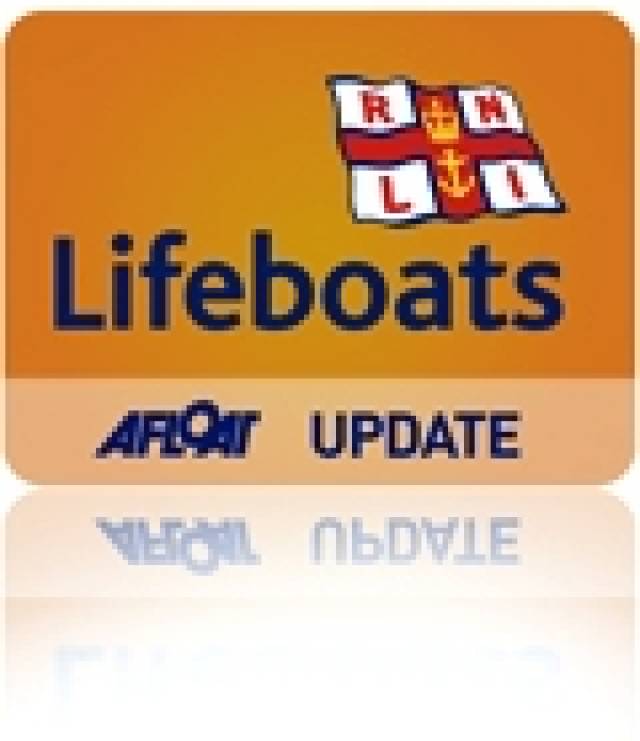#rnli – At a special ceremony held in Galway on Saturday the RNLI officially named its new Atlantic 85 lifeboat, Binny, at its station on the city's harbour. Pat Lavelle, Chair of the Lifeboat Management Group, handed over the lifeboat to the RNLI on behalf of the donor who had generously funded it through a gift left in her Will.
Audrey Lydia Finch from Devon funded the lifeboat which has been on service on Galway Bay since last year, in memory of her first husband Jack Binstead (Binny).
Mr Lavelle, a founding member of the Galway RNLI station, and a former Lifeboat Operations Manager, officially named the lifeboat during the ceremony.
The new state of the art Atlantic 85 lifeboat was introduced into the RNLI fleet in 2006. The lifeboat is 8.5 metres in length and weighs 1.9 tonnes. Improvements on its predecessor include a faster top speed of 35 knots, radar, provision for a fourth crewmember and more space for survivors.
Since the new lifeboat went on service in Galway, it has already launched 19 times and brought 10 people to safety.
Mike Swan, Galway RNLI Lifeboat Operations Manager, said the naming ceremony and service of dedication was a special occasion in the history of the Galway lifeboat station, adding that the volunteer crew is grateful to Mrs Finch for her generous legacy which funded the lifeboat.
He said the RNLI could not operate its lifeboats without the dedication of volunteer lifeboat crew and fundraisers: 'The crew in Galway give 100% at all times. Their commitment and ongoing attendance for training both here and at the lifeboat college means that they are highly proficient in the operation of our lifeboat. Further testament to the dedication of the crew is their knowledge that they may risk their own lives in the service of others'.
At a cost of €244,000 to fund the Atlantic 85 today, Mr Swan said legacy funding which in Galway's case had paid for the lifeboat, was of huge importance to the RNLI.
'As a charity, the RNLI relies on the generosity of the public for voluntary contributions and legacies. We are indebted to the fundraising support we receive to continuously train and equip our volunteer lifeboat crew here in Galway'.
It was following a number of incidents on Galway Bay that the decision was taken back in 1990 by the local RNLI committee that a lifeboat based in Galway would be invaluable. In 1994, it was announced that a B Class Atlantic 21 would be placed on a year's trial in Galway.
A temporary boathouse was built in 1996 and a temporary cabin arrived to serve as a crew room. Training continued until 27 March that year when the Galway lifeboat was officially put on service.
It was to be a busy start for the station's volunteer crew and it became the third busiest lifeboat station in Ireland that year.
A permanent boathouse was built in 1997 providing facilities for the lifeboat, a changing/drying room, workshop, fuel store, crew training room and an operational room. In that same year, a B class Atlantic 75 lifeboat B-738 RNLB Dochas was placed on service.
It was replaced by Binny, a B class Atlantic 85 lifeboat which was placed on service in 2011.
Mr Swan said: 'The rescue services on Galway Bay at the moment, I believe, are the best they have ever been. We are delighted to have representatives from all the other agencies here today. The training and dedication of the personnel in these services are second to none and I would like to thank them for making Galway Bay a safer place'.
A crowd of well wishers turned up to see the lifeboat officially named. A bottle of champagne was poured over the side of the lifeboat before it was launched at the end of the ceremony.
Among the guests were John Coyle, the President of Galway Lifeboat Station, who welcomed guests and opened proceedings and who later, in his capacity as Chair of the Irish RNLI Council, accepted the lifeboat on behalf of the RNLI. Music including the national anthem at the beginning of the ceremony was provided by St. Patrick's Band while Gareth Phillips sang Galway Bay and Home from the Sea.
MC for the event was Barry Heskin, a Deputy Launching Authority at Galway RNLI. The Very Reverend Richard A Lyny and Archdeacon Gary Hastings conducted the Service of Dedication.































































